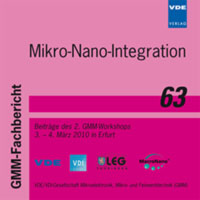CNTs - a Comparable Study of CNT-filled Adhesives with Common Materials
Conference: Mikro-Nano-Integration - 2. GMM-Workshops
03/03/2010 - 03/04/2010 at Erfurt, Germany
Proceedings: Mikro-Nano-Integration
Pages: 8Language: englishTyp: PDF
Personal VDE Members are entitled to a 10% discount on this title
Authors:
Heimann, Matthias; Boehme, Bjoern; Scheffler, Sebastian; Wolter, Klaus-Juergen (Technische Universität Dresden, Electronics Packaging Laboratory, Dresden, Germany)
Wirts-Ruetters, Martin (Fraunhofer Institute for Manufacturing Technology and Applied Materials Research Bremen, Germany)
Abstract:
Electronics packaging must be designed to meet the increasing requirements of the microelectronics industry. Future packages will have an even higher number of I/O’s and pitches down to 20 microns resulting in high dissipation losses and extreme current densities. When using conventional materials, design engineers will face physical barriers and limitations in performance and new material solutions have to be found. Reliable interconnects are a major concern of packaging technologies. The steadily increasing mechanical, thermal and electrical loadings open up new areas of research. One way to solve the problems of future electronics is the use of nanotechnologies and nanomaterials. Among the world's most researched materials are carbon nanotubes (CNTs). CNTs have excellent thermal, electrical and mechanical properties. They can be used in various ways. One researched field of application are CNT-polymer composites which combine common technologies with advanced materials. This paper focuses on the latest results obtained for CNT-filled adhesives for electronics packaging and compares the new materials with conventional, electrical Ag-filled conductive adhesives. Based on previous investigations on CNT-epoxy composites, a comprehensive study of the mechanical, electrical and thermal properties of selected promising candidates was conducted. Additionally, the performance of the novel composites as conductive adhesives in electronics packages was included in the evaluation.


